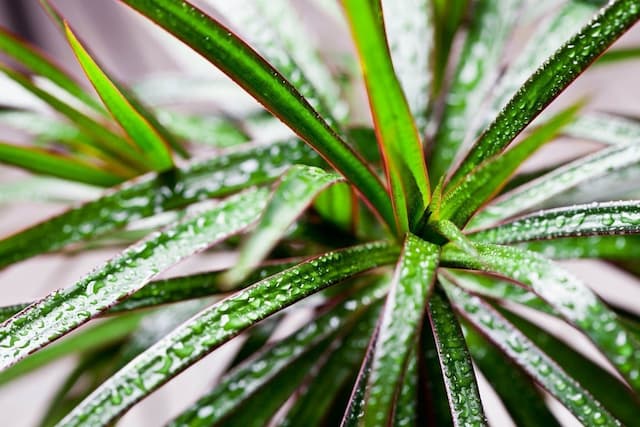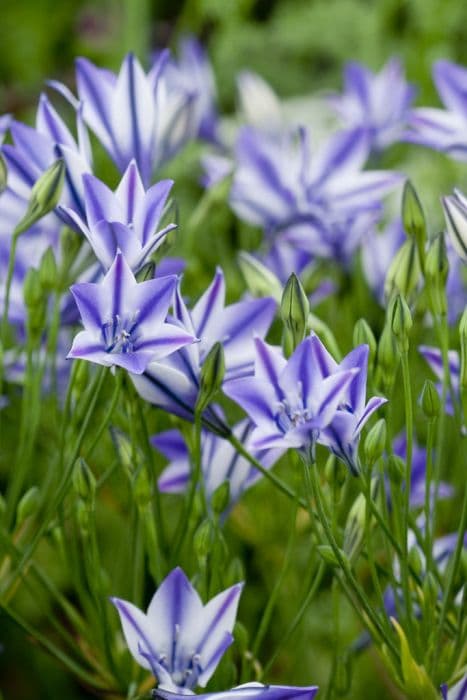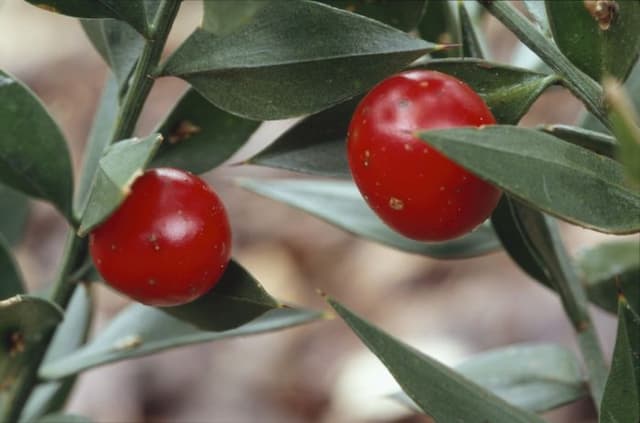Lilyturf Liriope muscari 'Big Blue'

ABOUT
Liriope muscari 'Big Blue', commonly known as Big Blue lilyturf, is a dense, herbaceous perennial with a grass-like appearance. Its foliage consists of long, slender, arching leaves that are a deep green color, contributing to a lush, tufted look. Throughout the growing season, the leaves form attractive, fountain-like clumps that serve as a verdant backdrop in any garden setting. In late summer to early fall, Big Blue lilyturf produces striking flower spikes that emerge from the center of the clumps. These flowers are usually a deep violet to purple color, arranged neatly in dense, grape-like clusters known as racemes above the foliage. As the flowers fade, they give way to small, rounded, blackish berries which may persist into the winter, providing visual interest even when most other plants have ceased blooming. The appearance of this plant, with its contrasting deep green foliage and vibrant purple flowers, makes it a popular choice for ground cover, edging pathways, or providing texture and color in rock gardens or borders. The evergreen nature of its leaves means that it offers year-round appeal, maintaining a tidy, almost manicured presence within the landscape.
About this plant
 Names
NamesFamily
Asparagaceae
Synonyms
Lilyturf, Monkey Grass, Big Blue Lilyturf, Big Blue Liriope
Common names
Liriope muscari, Ophiopogon muscari
 Toxicity
ToxicityTo humans
The plant commonly known as Lilyturf is generally considered non-toxic to humans. While it does not typically pose a threat, ingesting any part of the plant is not advised, and on rare occasions, it may cause mild stomach upset if ingested in large quantities. It's important to practice caution and keep the plant out of reach of small children who might chew on it.
To pets
Lilyturf is considered mildly toxic to pets, such as dogs and cats. If your pet ingests a part of this plant, they might experience gastrointestinal symptoms such as vomiting or diarrhea. It's advisable to keep an eye on your pet and consult a veterinarian if they exhibit any signs of distress after consuming the plant. While reactions are often mild, preventing access to the plant is the best course of action to avoid any potential issues.
 Characteristics
CharacteristicsLife cycle
Perennials
Foliage type
Evergreen
Color of leaves
Green
Flower color
Lavender
Height
1-1.5 feet (30-45 cm)
Spread
1-1.5 feet (30-45 cm)
Plant type
Herb
Hardiness zones
5-10
Native area
East Asia
Benefits
 General Benefits
General Benefits- Drought Tolerance: Once established, Liriope muscari 'Big Blue' has a high tolerance for drought, requiring minimal supplemental watering.
- Low Maintenance: This plant is known for being low maintenance, with minimal pruning or care required for it to thrive.
- Erosion Control: The dense growth habit of Liriope muscari 'Big Blue' helps to prevent soil erosion on slopes and in other vulnerable areas.
- Adaptable to Various Soils: This variety can thrive in a range of soil types, from acidic to alkaline, provided the soil is well-drained.
- Shade Tolerance: It can grow in full sun to full shade, making it versatile and suitable for various garden locations.
- Evergreen Foliage: This plant maintains its foliage year-round, providing consistent ground cover and color even in winter.
- Ornamental Interest: With its grass-like foliage and spiky purple flowers, Liriope muscari 'Big Blue' adds visual appeal to gardens and landscapes.
- Compact Growth: Its clumping growth habit makes it a good choice for borders, edging, and as a groundcover, without the risk of it becoming invasive.
 Medical Properties
Medical PropertiesThis plant is not used for medical purposes.
 Air-purifying Qualities
Air-purifying QualitiesThis plant is not specifically known for air purifying qualities.
 Other Uses
Other Uses- Liriope muscari 'Big Blue', commonly known as Big Blue Lilyturf, can be used to stabilize soil on slopes and prevent erosion due to its dense root system.
- This plant can act as a living mulch, suppressing weeds and retaining soil moisture when planted closely in garden beds.
- Big Blue Lilyturf can be used in between stepping stones or pavers to create a verdant, living pathway that tolerates foot traffic.
- The foliage of the plant provides a textured groundcover in woodland gardens, contributing to a naturalistic landscaping theme.
- Because it tolerates salt, it's useful for planting in coastal areas where many other plants might struggle due to salty conditions.
- Its dense growth habit makes Big Blue Lilyturf a practical choice for defining the edges of garden beds and pathways.
- The plant’s ability to thrive in shady conditions makes it ideal for underplanting beneath trees where other plants may not grow well.
- Big Blue Lilyturf can be used in containers or planters for adding greenery to patios, terraces, or balconies with limited space.
- During fall, the plant's seed heads can be used in dried floral arrangements, adding texture and interest to bouquets.
- It can serve as a turf grass alternative in low-traffic areas, offering a more eco-friendly and low-maintenance lawn solution.
Interesting Facts
 Feng Shui
Feng ShuiThe Lilyturf is not used in Feng Shui practice.
 Zodiac Sign Compitability
Zodiac Sign CompitabilityThe Lilyturf is not used in astrology practice.
 Plant Symbolism
Plant Symbolism- Perseverance: Liriope muscari 'Big Blue', also known as Lilyturf, has robust nature and can thrive in a variety of conditions which symbolizes resilience and the ability to persevere through challenges.
- Adaptability: Due to its versatility in landscaping, Lilyturf represents the ability to adapt to different situations and environments.
- Grounding: As a groundcover plant, Lilyturf symbolizes grounding and stability, offering a sense of being rooted and secure.
- Prosperity: With its lush foliage and purple flowers, Lilyturf can be seen as a symbol of abundance and prosperity.
- Peace: The soothing green of the Lilyturf's leaves and the gentle hue of its flowers can evoke a sense of calm and peace.
 Water
WaterThe Lilyturf should be watered generously during its growing season, which is spring and summer, ensuring the soil is kept moist but not waterlogged. During the fall and winter, reduce watering to prevent soggy soil, allowing the top inch of soil to dry out between waterings. It's recommended to water the plant with approximately 1 gallon of water every week during the active growth period, adjusting this amount during periods of rainfall or drought. In winter, water sparingly, enough to prevent the soil from completely drying out, which may amount to 1 gallon every two to three weeks depending on the humidity and temperature of your environment.
 Light
LightLilyturf thrives best in partial to full shade conditions, making it an excellent choice for shaded areas where other plants might struggle. The ideal spot for this plant is under the dappled light of a tree canopy or on the north side of a building. Avoid placing it in direct, harsh sunlight as it can scorch the foliage and compromise the plant's health.
 Temperature
TemperatureLilyturf is hardy and can tolerate a broad range of temperatures, typically surviving winter lows down to 10 degrees Fahrenheit and summer highs up to 95 degrees Fahrenheit. However, the ideal temperature range for this plant is between 60 and 75 degrees Fahrenheit, which promotes robust growth and flowering. Ensure that the plant is not subjected to sudden temperature fluctuations, which could cause stress and potential damage.
 Pruning
PruningLilyturf benefits from annual pruning to remove old foliage and encourage fresh, vibrant growth. The best time to prune is in late winter or early spring before new growth starts. Cut back the foliage to within a few inches of the base using sharp shears or a mower set at a high cutting height. Prune once a year, and optionally, remove spent flower spikes after blooming to maintain a tidy appearance and promote new flowers the following season.
 Cleaning
CleaningAs needed
 Soil
SoilLilyturf (Liriope muscari 'Big Blue') thrives in well-draining soil rich in organic matter with a slightly acidic to neutral pH of 5.5 to 7.0. A soil mix containing peat moss, compost, and perlite or sand is ideal to maintain adequate moisture while preventing waterlogging.
 Repotting
RepottingLilyturf typically does not require frequent repotting as it tolerates being slightly root-bound. Repotting every 2-3 years or when the plant has clearly outgrown its container will suffice.
 Humidity & Misting
Humidity & MistingLilyturf is versatile and can tolerate a wide range of humidity levels; however, it prefers moderate humidity. Normal indoor humidity levels are generally suitable for its growth without the need for special humidity adjustments.
 Suitable locations
Suitable locationsIndoor
Place Lilyturf in bright, indirect light and water moderately.
Outdoor
Plant Lilyturf in part-shade to full sun with well-draining soil.
Hardiness zone
5-10 USDA
 Life cycle
Life cycleLiriope muscari 'Big Blue', commonly known as Lilyturf or Big Blue Liriope, begins its life as a seed, which, once sown, germinates in favorable conditions of warmth and moisture, developing into a seedling with a small rosette of leaves. The seedling grows through vegetative growth into a mature clump-forming perennial, with grass-like foliage and dense, tufted growth habit. During its growing season in spring and summer, the plant produces spikes of small, purple, lavender, or white flowers that rise above the foliage, attracting pollinators such as bees. Following flowering, which typically occurs from late summer to fall, the plant may produce berry-like fruits that contain seeds, which can disperse to propagate new plants. Lilyturf is also capable of vegetative reproduction through its rhizomatous root system, spreading to form wider colonies over time. After several years, older clumps may become crowded and can be divided in early spring or fall to rejuvenate the plant and encourage new growth.
 Propogation
PropogationPropogation time
Spring-Fall
The Liriope muscari 'Big Blue', commonly known as Big Blue Lilyturf, is ideally propagated by division. The best time for dividing Big Blue Lilyturf is in the early spring before new growth begins or in the late fall after the plant has finished flowering. To propagate by division, you should gently dig up an established clump of Lilyturf and shake or wash off the soil to reveal the root system. Using your hands or a sharp knife, divide the clump into smaller sections, ensuring that each section has a good amount of roots and several leaves or growing points. These divisions can then be replanted immediately at the same depth they were growing before, spaced about 12 inches (approximately 30 centimeters) apart to allow for spreading. Water the newly transplanted divisions well to help establish them. This method of propagation is straightforward and helps to rejuvenate older clumps that may have become woody or less vigorous with age.









